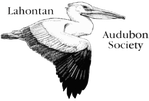|
By Kevin J. DesRoberts and Jeanne R. Tinsman The Corn Creek Important Bird Area (IBA) encompasses a unique combination of habitats that are critical to migratory birds and other species of wildlife. This IBA includes portions of the Desert National Wildlife Refuge (DNWR), the Tule Springs Fossils Beds National Monument (managed by the National Park Service), lands managed by the Bureau of Land Management and Department of Defense, and the private community of Corn Creek. A major component of the IBA is a large area dominated by saltbush (Atriplex spp.) with surrounding creosote bush (Larrea tridentata), located between the Corn Creek Field Station and highway 95. This area supports the highest density of Le Conte’s Thrasher (Toxostoma lecontei) nests and pairs/hectare in Clark County. It also provides important breeding habitat for Bell’s Sparrow (Artemisiospiza belli), Black-throated Sparrow (Amphispiza bilineata) and Horned Lark (Eremophila alpestris), as well as wintering habitat for Sagebrush Sparrow (Artemisiospiza nevadensis) and Sage Thrasher (Oreoscoptes montanus). Corn Creek is the only perennial stream in the 1.6 million-acre DNWR; it supports important riparian and wetland vegetation. This habitat, with its irrigated orchard, its mix of native and nonnative trees and shrubs, and its surrounding groves of honey mesquite (Prosopis glandulosa), adds tremendous value to this IBA for numerous bird species. The Corn Creek area is an oasis in the Mojave Desert, with abundant food resources that include insects, fruit, and seeds. Over 30 bird species breed within the IBA, including Le Conte’s and Crissal Thrashers, Bell’s Sparrow, Phainopepla, Lucy’s Warbler, Say’s and Black Phoebes, Anna’s and Black-chinned Hummingbirds, Verdin, Bell’s Vireo, Blue Grosbeak, Cooper’s Hawk, Common Raven, and Long-eared Owl. A multitude of vagrants show up during the spring and autumn migration seasons; a small sampling consists of Rufous-backed Robin, Varied Thrush, Brown Thrasher, Tropical Kingbird, Rose-breasted Grosbeak, Lewis’s Woodpecker, Dickcissel, Northern Parula, American Redstart, Gray Catbird, Orchard Oriole, and Field Sparrow. Over 150 species of birds can be observed over the course of a migration season, making Corn Creek one of the premier birding hotspots in southern Nevada. The U.S. Fish and Wildlife Service restored habitat along Corn Creek and in the surrounding uplands in 2011 and 2014, and additional habitat enhancement is being planned for upland areas and the orchard. Invasive species control will also be a focus over the next few years. The cement-lined pond constructed in 2011 provides water storage for the fire protection system and reduces energy use for the HVAC system for the visitor center, while providing open water habitat for birds and other wildlife, including a population of the endangered Pahrump Poolfish (Empetrichthys latos). Key partners involved with the protection and enhancement of the IBA include Nuwu/Nuwuvi (Southern Paiute/Chemehuevi) tribes, Nevada Department of Wildlife, National Park Service, Great Basin Bird Observatory, Red Rock Audubon Society, Great Basin Institute, Southern Nevada Conservancy, Friends of Nevada Wilderness, and Get Outdoors Nevada. |
topics
All
Archives
July 2024
|



 RSS Feed
RSS Feed